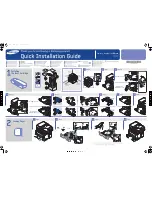
Programming Codes
T480
Programmer’s Guide
Page
96
Rev A
100-14362
Code 128 (Code-128(A,B, and C))
Code 128 is an alphanumeric bar code. It is a high-density, variable-length, continuous
code, which employs multiple element widths. Code 128 has three possible start codes.
The start code defines the code set, Code A, B, or C that will be used to generate the
barcode. The EPIC 3000 allows the code set to be specified, or it can be select by the
printer based on the information in the data field.
To specify code set: [ESC] b <2> <Code>{information} [NUL]
Function
Code 128 Manual Encoding
ASCII
[ESC] b <2> <Code>{information} [NUL]
Hexadecimal
1BH 62H <2> <Code>{information} [NUL]
Decimal
<27> <98> <2> <Code>{information} [NUL]
If the first character in the data field <Code> is a start code as shown in Figure 11 below,
the printer will print the complete data field from the selected set. Due to space
limitations, only ten characters can be printed. The check digit is generated and printed
by the printer. Characters are also specified as shown in Figure 11.
Space is defined as a <0>, which makes programming difficult and causes control
character conflicts for the printer. To solve this problem, the EPIC 3000 Printer subtracts
32 from all characters that are to be included in the bar code. In the Code 128 definition,
an ‘A’ is <33>; however, the printer converts an ASCII ‘A’ (<65>) to a <33> internally.
This sets Code 128C and the start codes off by 32.
Barcode 128 consists of 107 unique symbols. 101 of the symbols take on different
meanings based on the start code or an embedded shift code sequence. Code stick A
consists of alphanumeric characters and ASCII control codes (see the table below).
Code stick B consists of Alpha numeric with lower case alpha, Code stick C consists of
numeric pairs.
In most cases, the EPIC 3000 will generate the most compact barcode for you.
However, if it is desirable to have complete control, the programmer should use manual
mode.
[ESC]b<2><137><44><66><132>Parts[NUL]
Start with Code C, <44> is for character pair 12, <66> is
for character pair 34, <132> shifts to Code B, then it’s
followed with the characters
“Parts” and the ending
[NUL].
Figure 8 Code 128 Manual Encoding Example
















































